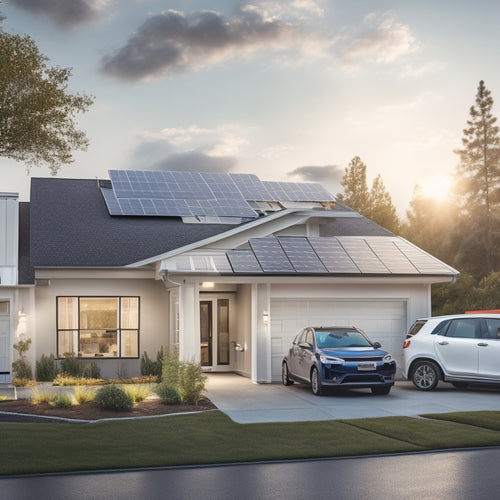Top Solar Energy Solutions for Small Businesses
Share
As a small business owner, you can substantially reduce your energy costs and carbon footprint by investing in top solar energy solutions, which can provide a return on investment of up to 15% annually. By switching to solar, you'll not only lower your electricity bills but also contribute to a cleaner environment. With incentives like the federal Solar Investment Tax Credit and state rebates, the upfront cost of installation can be substantially reduced. You'll be able to generate electricity, export excess to the grid, and even store energy for later use. Now, discover how to optimize your solar energy system for maximum ROI and learn how to take the first step towards energy independence.
Key Takeaways
• Solar energy systems reduce reliance on fossil fuels, contributing to a cleaner and healthier environment, and minimizing carbon footprint.
• Evaluating system design options and conducting site assessments ensure maximum energy production and cost savings for small businesses.
• Solar energy solutions provide energy independence, create new job opportunities, and stimulate local economies, especially in rural areas.
• Governments offer incentives, such as the federal Solar Investment Tax Credit, to encourage solar energy adoption and promote community engagement.
• Conducting energy audits and optimizing energy usage help small businesses reduce energy consumption, minimizing waste and lowering electricity bills.
Benefits of Solar Energy Systems
By integrating solar energy systems into your daily life, you can substantially reduce your reliance on fossil fuels and lower your carbon footprint.
This, in turn, minimizes the environmental impact of your energy consumption, contributing to a cleaner and healthier environment.
With solar energy, you're not only reducing your carbon footprint but also gaining energy independence.
This is especially vital for rural areas where energy access can be limited.
In addition, the growth of the solar industry creates new job opportunities, stimulating local economies and promoting rural development.
Governments worldwide are implementing policies to encourage the adoption of solar energy, recognizing its potential for community engagement and air quality improvement.
Commercial Solar Panel Solutions
As you explore commercial solar panel solutions, you'll need to examine the system design options that best fit your business's energy needs.
You'll also need to decide on the panel installation methods that work best for your facility, whether that's a rooftop or ground-mounted system.
System Design Options
When designing a commercial solar panel system, you'll need to weigh several system design options to guarantee maximum energy production and cost savings.
To ensure a successful installation, it's crucial to consider the following key aspects:
Structural Assessments
Evaluate your building's structural integrity to ensure it can support the weight of the solar panels and withstand various weather conditions.
Load Calculations
Determine your energy requirements by calculating your business's energy load to size the solar panel system accurately.
System Sizing
Select the optimal system size based on your energy needs, available roof space, and local building codes.
Panel Orientation and Tilt
Optimize panel orientation and tilt to maximize energy production, taking into account your location's solar irradiance and shading factors.
Panel Installation Methods
You've sized your commercial solar panel system, now it's time to deliberate the physical installation of the panels, which involves evaluating various panel installation methods to guarantee a secure, efficient, and code-compliant setup.
When it comes to panel installation, you'll need to assess your building's roof topology, including its size, shape, and orientation. This will help determine the most suitable installation method for your system.
For instance, if your roof has a complex design or multiple skylights, a roof-mounted system might be more challenging to install. In such cases, ground mounting could be a better option.
Ground mounting involves installing panels on the ground, which can provide more flexibility with regard to system design and layout. Additionally, ground-mounted systems can be more accessible for maintenance and repair.
On the other hand, roof-mounted systems can be more aesthetically pleasing and may be more suitable for buildings with limited land availability.
Energy Efficiency Gains
By integrating commercial solar panel solutions, businesses can substantially reduce their energy consumption and lower their electricity bills, resulting in substantial cost savings over time.
As you consider transitioning to solar energy, it's essential to understand the energy efficiency gains that come with it. A crucial step in this process is conducting energy audits to identify areas of inefficiency and opportunities for improvement.
By implementing energy-efficient solutions, you can:
Reduce energy consumption: Optimize your energy usage and minimize waste.
Lower energy costs: Decrease your electricity bills and allocate funds to other business needs.
Achieve carbon reduction: Contribute to a more sustainable environment by reducing your carbon footprint.
Enhance your brand reputation: Demonstrate your commitment to sustainability and appeal to environmentally conscious customers.
Reducing Energy Costs With Solar
Switching to solar energy can substantially lower your electricity bills, especially for homeowners and businesses with high energy consumption. By harnessing the power of the sun, you can reduce your reliance on the grid and enjoy significant cost savings. But before making the switch, you must conduct an energy audit to identify areas of inefficiency in your current energy usage.
| Energy Audit Step | Description | Cost Savings |
|---|---|---|
| Identify Energy Hogs | Pinpoint appliances and systems consuming the most energy | 10-20% |
| Optimize Energy Usage | Implement energy-efficient practices and habits | 5-10% |
| Upgrade to Energy-Efficient Equipment | Replace outdated equipment with energy-efficient alternatives | 15-30% |
| Install Solar Panels | Harness the power of the sun to generate electricity | 50-70% |
Small Business Solar Incentives
As a small business owner, you're likely aware that investing in solar energy can be a costly upfront endeavor, but fortunately, various incentives are available to help offset the expenses and make the shift to solar more financially viable.
One of the most significant benefits is the federal Solar Investment Tax Credit (ITC), which allows you to claim a tax credit of 26% of the total cost of your solar energy system.
Many states offer rebates and other incentives to encourage the adoption of solar energy.
State Rebates: Many states offer rebates for small businesses that invest in solar energy, which can help reduce the upfront cost.
Tax Credits: In addition to the federal ITC, some states offer their own tax credits for solar energy investments.
Net Metering: This incentive allows you to generate your own electricity and export any excess to the grid, reducing your energy bills.
Performance-Based Incentives: Some utilities and states offer incentives based on the actual performance of your solar energy system.
Solar Energy Storage Systems
As you explore solar energy storage systems, you'll encounter two primary options: battery backup systems and grid tie systems.
These systems serve distinct purposes, and understanding their differences is crucial for selecting the best fit for your solar energy solution.
Battery backup systems store excess energy generated by your solar panels during the day for use during periods of low sunlight or at night.
Grid tie systems, on the other hand, allow you to sell excess energy back to the grid and offset your energy costs, but they do not provide backup power during outages.
You'll want to weigh how these systems can address your energy needs, ensuring a reliable supply of power when the sun isn't shining.
Battery Backup Systems
When considering a solar energy system, you'll need a reliable battery backup system to store excess energy generated during the day for use during nighttime or power outages. This is especially vital for small businesses that rely on continuous operations.
A battery backup system guarantees that your business stays powered during emergency situations, minimizing losses and downtime.
Reduced downtime: With a battery backup system, you can continue to operate during power outages, reducing the risk of lost productivity and revenue.
Emergency power: A battery backup system serves as an emergency power source, providing backup power during outages or natural disasters.
Reduced energy costs: By storing excess energy generated during the day, you can reduce your energy costs and rely less on the grid.
Increased reliability: A battery backup system provides an additional layer of reliability, guaranteeing that your business stays powered even when the grid is down.
Grid Tie Systems
You can harness the full potential of your solar energy system with a grid tie system, which enables you to sell excess energy back to the grid and offset your energy costs. This system allows you to generate revenue by selling excess energy to the utility company, reducing your energy bills. With a grid tie system, you can maximize your solar energy production and reduce your reliance on the grid.
Grid tie systems offer several benefits:
| Feature | Benefit |
|---|---|
| Grid Safety | Guarantees safe and reliable operation of your solar energy system |
| System Monitoring | Allows you to track your energy production and consumption in real-time |
| Energy Offset | Enables you to sell excess energy back to the grid and offset your energy costs |
| Increased Efficiency | Optimizes your solar energy production and reduces energy waste |
Commercial Solar Installation Process
Your commercial solar installation process typically begins with a thorough site assessment, where a team of experts evaluates your building's energy usage and suitability for solar energy integration. This assessment helps determine the optimal system size, panel placement, and energy output for your business.
During the site assessment, the team will:
Evaluate your energy usage: Analyzing your past energy bills to determine your energy consumption patterns.
Assess your roof's condition: Inspecting your roof's age, size, and material to ensure it can support the solar panels.
Identify potential shading issues: Determining if any obstructions, such as trees or nearby buildings, could impact energy production.
Determine the optimal system design: Based on the assessment, the team will design a customized solar system that meets your energy needs and maximizes energy production.
After the site assessment, you'll receive a detailed project proposal outlining the installation timeline, system specifications, and expected energy savings. This proposal will help you understand the project's scope, costs, and benefits, ensuring a seamless transition to renewable energy.
Maximizing Solar ROI Potential
To maximize your solar ROI potential, you must optimize system performance, monitor energy production, and take advantage of available incentives and tax credits.
A thorough solar audit can help identify areas for improvement, ensuring your system is running at peak efficiency. This involves evaluating your energy usage patterns, inspecting your equipment, and identifying potential upgrades or repairs.
By conducting regular energy forecasting, you can better predict your energy needs and adjust your system accordingly. This data-driven approach enables you to make informed decisions, reduce energy waste, and increase your ROI.
In addition, staying up-to-date on available incentives and tax credits can substantially boost your returns. By taking advantage of these benefits, you can offset the initial investment costs and accelerate your payback period.
Frequently Asked Questions
How Do I Ensure My Solar Panels Are Snow-Load Certified?
When you install solar panels, guarantee they're snow-load certified to guarantee structural integrity. In winter, perform regular maintenance to clear snow, checking for weight capacity and verifying your system can withstand harsh weather conditions.
Can I Install Solar Panels on a Metal Roof?
When installing solar panels on a metal roof, you'll need to verify the roof material can support the added weight and potential snow load, while maintaining its structural integrity, so consult with a professional to assess feasibility.
Do Solar Panels Work During Power Outages?
During power outages, you'll need backup systems like batteries or generators to keep your solar panels working, ensuring grid resiliency; without them, your panels won't function, as they're designed to sync with the grid's frequency.
Are Solar Panels Resistant to Hail Damage?
You're wondering if solar panels can withstand hail storms? Most modern panels are designed to resist hail damage, with a rating of up to 1-inch hailstones at 50 mph, ensuring your investment remains weather-durable.
Can I Sell Excess Energy Back to the Grid?
You can sell excess energy back to the grid through Net Metering, earning Renewable Credits. With a grid connection, you'll need Energy Storage to store excess energy, allowing you to reap the benefits of your solar investment.
Related Posts
-

What Electric Vehicle Owners Need for Home Energy
As an electric vehicle owner, you need to optimize your home energy system to guarantee efficient, sustainable, and c...
-

3 Best State and Local Solar Incentives USA
You can greatly reduce your energy dependence and save thousands of dollars by taking advantage of the top state and ...
-

What You Need to Know About RV Solar Maintenance
When you're out on the road, your RV's solar panel system is your lifeline. But without regular maintenance, you're l...


